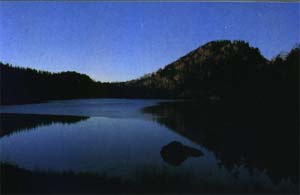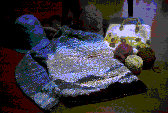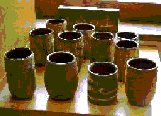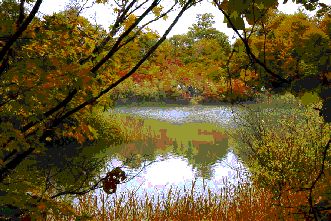North Otari
Kita Otari
The Hime river runs down to the lowest point
of Otari village to the north. Kita Otari
is located at the north-west edge of Nagano
Prefecture and is neighboring to Niigata
Prefecture. The Hime river flows along an
Earthquake Fault line.
Surrounded by those unexploited mountains,
this area is recently consists of a main
cluster of a school , shops and offices alongside
of Route 148. Others are out-of-the-way clusters.
You have to drive steep ways up on the both
sides of the river to reach old clusters
of farm houses. Hot spas on Hime river are
available from old days for travellers to
and from the Japan Sea area. From here to
the Japan Sea , it takes only 40 minutes
drive.
Villagers around here like to visit beautiful
seashore and fisherman's wharf on the sea.
They say Kita-Otari villagers are more connected
to Itoigawa city in terms of shopping.
Kazafuki- Oike pond
Kazafuki-Oike Pond
This is one of the biggest highland ponds
in Japan. From Inunosu observatory, you can
overlook Kazafuki-Oike Pond and surrounding
Koshikino-ike Pond, Shinabachino-ike Pond,
and Chino-ike Pond. A hiking couse will lead
you to Kamino-tambo,( god's rice field)and
Tengu-hara (devil- bird field ), then around
Kazafuki-Oike Pond.
You@will find many species of alpine plants
along your way.
It is a 30 minutes drive from Nakatsuchi
station of JR Oito line to the Kitano cluster
and from there it takes 3 hours walk to the
ponds. The mountain cottage opens from June
to the 2nd Sunday of October.
Phone number is 0261-85-1053. The pond is
1,780m above sea level with its circumstance,
1,300m and depth 5.5m.
Milch-no-eki Spa-Village market station
This is built for the driver-travelers. Those
who travel long could take a good rest here.
You can find specialities such as natural
food and or traditional handicrafts. It has
a nice indoor and outdoor spa for every visitor.
They are also planning to have a sort of
native culture school on occasion.



Kuruma stratum
Near Kuruma spa there is a well-known Kuruma
Stratum where a fossil footprints of Dinosaur
was found in 1994.
Kuruma spa
You can enjoy a wide view of the Hime river
from this spa. Those climbers to Mt.Kazafuki
dake can start from here.
Shima spa
Himekawa spa
In spring cherry blossoms on the road are
beautiful. After the landslide of 1995, hotel
buildings were reconstructed. As it is located
on the prefectural border between Nagano
and Niigata , you can taste fresh mountain
vegetable and fish in all four seasons.
Jyohoji temple
Opened in A.D.808 ( Heian era) under the
denomination of Shingon Shu sect. Buddhism this temple was desolated
once. Then in the Edo era it had reopened
under today's denomination, Soto sect Buddhist temple . Highly honored Buddhist
statues Amida nyorai with two samurai statues were nominated
as Nagano prefectural historical treasures
in 1996. The temple has more than 760 kinds
of Buddhist statures and those who hope to
practice Zen sitting meditation will be accepted
for a day course. Appointment is required.
Tel . 0261-85-1061
Oami
Through the Himekawa spa and up the mountain,
you can find a once prosperous village community.
Oami was one of the three biggest stages
in Otari in line with Kuruma and Chikuni
along the Salt Road in the Edo era. Shiogura a salt warehouse built in old days is still
existing in the village. When the transporters
rested their oxen, they kept the baggage
salt on mezzanine and oxen downstairs. No
nail was used in the building structure because
salt rusts nails.
Villagers play Oami Fire Festival with Himekawa
Drum sounds at Amidagahara field every first
Saturday of February.
They sometimes cook traditional dish such
as , Sasamochi(Sasa is bamboo grass) and
Tochimochi( Tochi is Japanese horse-chestnut),
using its local plants.
OBS
In such a border district, you'll find unexpectedly,
OBS- Outward Bound School, which is a worldwide,
educational organizations. Mainly youngsters
attend these outbound activities such as
rock climbing, mountaineering, and river
climbing in a way they can discover their
own selves.
Hana-tolo in Azamiya-suwa-shrine
People live in Fukahara and Sumomodaira area
in Kita-Otari have worshiped azamiya-suwa
shrine. At the festival held on the first
Saturday night in every September, you can
see 12 pieces of Hana-tolo. Hana-tolo is a lantern decimated with paper
flowers. It is made of a bamboo about 7 meters
tall, and from the top of it , 30 twigs are
hanbinb down. Each twig are decorated with
800 white paper flowers. Residents gather
to make those flowers to prepare for the
festival. At the festival, people walk in
procession to the shrine holding 12 hana-tolos
and dedicate them to Ujigami , a guardian deity god. The floating line
of Hana-tolos bright in dusk is fantastic
and even graceful.
Nakaya dani valley
Just turn to the east at Otari Onsenguchi-
on route 148, you will run into old days
Japanese village. Old folklores sound almost
real if you listen to them in a village farm
houses in this valley.
Nakaya Omiya Suwa shrine
At the final weekend in every August, Shinto
festival is held. Yoimatsuri, i.e.,evening
festival (eve) is held on Saturday, then
Honmatsuri .i.e.,main festival on Sunday.
It will display a series of traditional and
photogenic performances like Yakko dance, lion dance, Kurun byoshi ( prosperity dance, and Urayasu-no-mai ( Shinto prosperity dance). We can enjoy
historic scenes of Japanese local community.
Yakko dance with its petition song ( Yakko uta ) has been handed down from the Edo era when
villagers could only make their stand to
the ruler clear in their ballad once in each
year at this festival. It was right before
the god and with the dance,
Mountain and Village life experience dormitory
Primary and middle school children from city
areas spend their semesters here experiencing
traditional village and outdoor life. They
commute to village school and enjoy outdoor
sports of four seasons. Educational purpose
of this experience it to foster independent
life and manner of boys and girls.
Otari Spa
The Takeda clan of before Tokugawa era visited
this spa in secrecy. Later people from Japan
Sea coast walked up to this spa through Yu-Touge
pass.Yu means spa. Otari spa is of three
different waters whose ingredients and effects
are quite different. In spring, mountain
skiing here around is very popular.
Mt.Amakazari
This is all the season beautiful mountain
is 1963m high. Climbers often say that it
is more than expected. They mean both hardness
to climb and beauty they enjoyed . The fauna
and flora of this independent peak is separated
and unique. Kyuya Fukada a well-known mountain
essayist, wrote on Mt. Amakazari in his famous
essay titled " Japanese 100 favorite
mountains" . On the track we could see
Mizubasho( skunk cabbage) around springs
and in the running water Japanese char( mountain
trout).
Lately, Otari village opened drive-in camping
field for the family campers and mountain
climbers. They have summer naturing and traditional
craft making, cooking classes for the staying
campers. Instructors are mainly elderly villagers.
Kama-ike Pond
Surrounded with beech trees and more than
400 kinds of flora under them, it maintains
primordial state of deep forest. It is a
nice place for the nature-watchers to visit.
Generations of villagers used to visit here
to enjoy the beauty of water which mirrors
changing skies and Autumn leaves. You can
trek to Mt. Onagi from here. Bunarin-tei
Japanese style restaurant is a place to take
rest for elderly.
Mt. Onagi
Mt.Oonagi is 1566m high and located to the
northern end of Nagano Prefecture. It is
an independent peak. If the weather is fine
enough you can have a broad view over to
Noto-peninsula and Toyama-bay from the north
top. The name `Oonagi` which means a big
beach comes from its unique shape when fishermen
recognize it as a landmark of Itoigawa port.
Anybody can climb this mountain, as it is
only 2km to the top from Yu pass. Enthusiastic
skiers enjoy ski tour in May.
Top ¢Otari Top page ¢North Otari ¤Center Otari¤ South Otari





